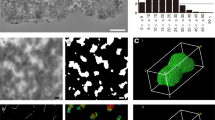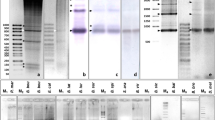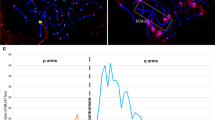Abstract
A SIMPLE technique is described here which locates regions of satellite or highly repetitive DNA within mammalian metaphase chromosomes and helps the study of relationships between these regions and those which are heterochromatic and late replicating. The technique arose from attempts to hybridize radioactively labelled satellite DNA from mouse1, guineapig2 and calf3 in situ with complementary regions in metaphase chromosomes, as described by Jones4 and Pardue and Gall5. The areas of hybrids formed in this manner were always located around the centromere. Using the Giemsa stain we also observed that these areas stained more darkly than the remainder of the chromosome material on denaturation and reassociation in situ, without the addition of satellite DNA. This indicated that, even in these conditions, there is re-association of the satellite DNA strands and that there may be a simpler technique in which no satellite DNA need be added. Ideally, a clear picture of the satellite DNA would be obtained in metaphase chromosomes by denaturing the DNA strands and allowing them to reassociate for varying times in an adequate buffer. In this manner, with increasing time of reassociation there would be within the chromosomes a progression of darkly staining regions of satellite DNA which would contrast sharply with lightly staining regions of the remaining DNA.
This is a preview of subscription content, access via your institution
Access options
Subscribe to this journal
Receive 51 print issues and online access
$199.00 per year
only $3.90 per issue
Buy this article
- Purchase on Springer Link
- Instant access to full article PDF
Prices may be subject to local taxes which are calculated during checkout
Similar content being viewed by others
References
Yasmineh, W. G., and Yunis, J. J., Biochem. Biophys. Res. Commun., 35, 779 (1969).
Yunis, J. J., and Yasmineh, W. G., Science, 168, 263 (1970).
Yasmineh, W. G., and Yunis, J. J., Exp. Cell Res., 64, 41 (1971).
Jones, K. W., Nature, 225, 912 (1970).
Pardue, M. L., and Gall, J. G., Science, 168, 1356 (1970).
Conn, H. J., Darrow, M. A., and Emmel, V. M., Staining Procedures, second ed., No. 136 (Williams and Wilkins, Baltimore, 1960).
Ohno, S., Kaplan, W. D., and Kinosita, R., Exp. Cell Res., 13, 358 (1957).
Church, K., Genetics, 52, 843 (1965).
Schmid, W., Cytogenetics, 2, 175 (1963).
Yunis, J. J., Nature, 205, 311 (1965).
Schmid, W., Arch. Klaus-Stift. Vererb-Forsch., 42, 1 (1967).
Pflueger, O., and Yunis, J. J., Exp. Cell Res., 44, 43 (1966).
Yunis, J. J., and Yasmineh, W. G., in Advances in Cell and Molecular Biology (edit. by DuPraw, E. J.), 2 (Academic Press, New York, 1972).
Corneo, G., Ginelli, E., and Polli, E., J. Mol. Biol., 48, 319 (1970).
Author information
Authors and Affiliations
Rights and permissions
About this article
Cite this article
YUNIS, J., ROLDAN, L., YASMINEH, W. et al. Staining of Satellite DNA in Metaphase Chromosomes. Nature 231, 532–533 (1971). https://doi.org/10.1038/231532a0
Received:
Revised:
Issue Date:
DOI: https://doi.org/10.1038/231532a0
This article is cited by
-
Standardized karyotypes for the greater Galagos, Galago crassicaudatus E. Geoffroy, 1812 and G. garnettii (Ogilby, 1838) (Primates: Prosimii)
Genetica (1987)
-
The structural basis for C-banding
Chromosoma (1985)
-
Localization of actin-related sequences by in situ hybridization to R-banded human chromosomes
Chromosoma (1984)
-
Variable C-banding pattens and a proposed C-band karyotype in Gallus domesticus
Genetica (1981)
-
The mechanism of C-banding: depurination and ?-elimination
Chromosoma (1979)
Comments
By submitting a comment you agree to abide by our Terms and Community Guidelines. If you find something abusive or that does not comply with our terms or guidelines please flag it as inappropriate.



